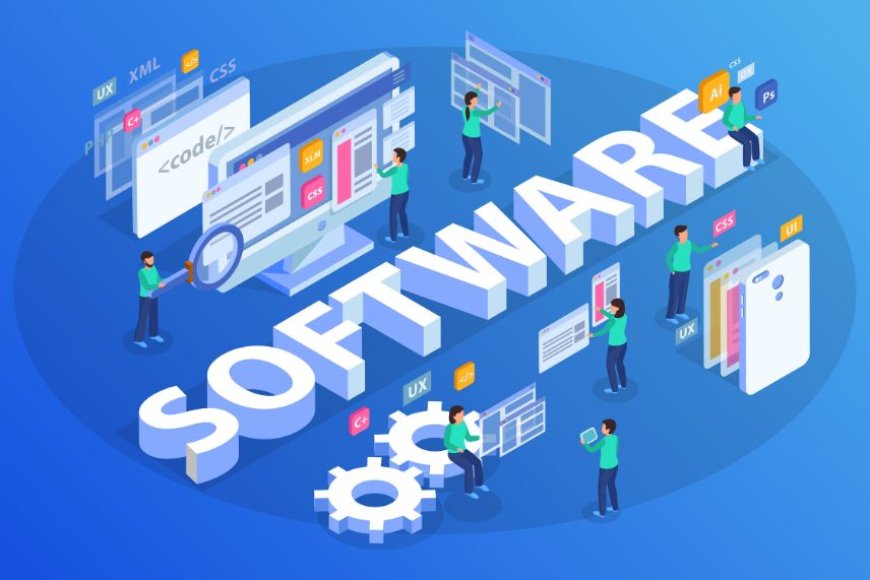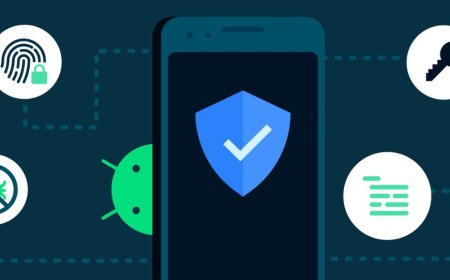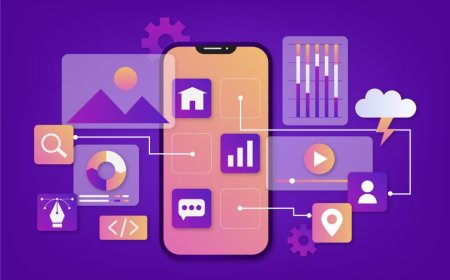The Evolution of Software: From Past to Present
Tectoks takes you on a journey through the evolution of software, from its humble beginnings to the cutting-edge technology of today.

Table of Contents:
-
Introduction
-
Software Development History
-
Software Architecture Evolution
-
Software Characteristics
-
Software Application
-
Conclusion
1. Introduction
Software is a set of instructions or programs that tell a computer or a device how to perform a specific task. Software can be classified into two main types: system software and application software. System software is the software that runs the computer hardware and provides basic functionality for other software. Application software is the software that performs specific tasks for the user, such as word processing, web browsing, gaming, etc.
Software development is the process of generating, designing, testing, and maintaining software. Software development has a long and rich history, spanning from the early days of programming languages and operating systems to the modern era of cloud computing and artificial intelligence.
Here are some of the major milestones in the history of software development:
-
1940s–1950s: The first programming languages were developed, such as Assembly, Fortran, and Lisp. These languages were low-level, meaning they were close to the machine code that the computer understood but difficult for humans to read and write.
-
1960s–1970s: The first operating systems were developed, such as Unix, DOS, and Windows. Operating systems are software programs that manage the resources and activities of a computer. They provide a common interface for the user and the application software. The first high-level programming languages were also developed, such as C, Pascal, and Basic. These languages were more abstract and easier for humans to read and write but they still required a compiler or an interpreter to translate them into machine code.
-
1980s–1990s: The first graphical user interfaces (GUIs) were developed, such as Mac OS, Windows, and Linux. GUIs are software that allows the user to interact with the computer using visual elements, such as icons, menus, and windows. The first object-oriented programming languages were also developed, such as C++, Java, and Python. These languages are based on the concept of objects, which are entities that have attributes and behaviors. Object-oriented programming languages allow for better organization, reuse, and abstraction of code.
-
2000s–present: The first cloud computing platforms were developed, such as Amazon Web Services, Google Cloud Platform, and Microsoft Azure. Cloud computing is a model of software delivery that allows the user to access software and data over the internet without having to install or maintain them on their own devices. Cloud computing enables the scalability, reliability, and cost-efficiency of software. The first artificial intelligence (AI) applications were also developed, such as Siri, Alexa, and Cortana. AI is a branch of software that aims to create machines or systems that can perform tasks that normally require human intelligence, such as speech recognition, natural language processing, computer vision, and machine learning.
The purpose of this blog post is to provide an introduction to software and its main functions and features. It also provides some historical background and context for software development, from the early days of programming languages and operating systems to the modern era of cloud computing and artificial intelligence. The scope of this blog post is limited to the general overview of software and its history and does not cover the details of specific software products, technologies, or methodologies.
2. Software Development History
Software development history is a fascinating topic that covers the evolution of software from its origins to its current state. Software development has gone through several stages and paradigms, each with its own challenges, opportunities, influences, and impacts.
Here is a brief overview of some of the main aspects of software development history:
-
Structured programming: This is a paradigm of software development that emerged in the 1960s and 1970s, based on the idea of dividing a program into smaller and simpler units, called subroutines or functions, that can be reused and tested independently. Structured programming aims to improve the readability, maintainability, and reliability of software by avoiding the use of unstructured control flow statements, such as goto, that can create complex and tangled code. Some of the main languages that support structured programming are C, Pascal, and Ada.
-
Object-oriented programming: This is a paradigm of software development that emerged in the 1980s and 1990s, based on the idea of modeling a program as a collection of objects, which are entities that have attributes and behaviors. Object-oriented programming aims to improve the modularity, reusability, and extensibility of software by encapsulating data and operations within objects and allowing objects to interact with each other through messages. Some of the main languages that support object-oriented programming are C++, Java, and Python.
-
Functional programming: This is a paradigm of software development that emerged in the 1990s and 2000s, based on the idea of treating a program as a mathematical function, that is, a mapping from inputs to outputs. Functional programming aims to improve the correctness, conciseness, and parallelizability of software by avoiding the use of mutable states, side effects, and imperative commands and relying on pure functions, higher-order functions, and recursion. Some of the main languages that support functional programming are Lisp, Haskell, and Scala.
-
Agile development: This is a methodology of software development that emerged in the 2000s and 2010s, based on the idea of delivering software in short and frequent iterations rather than in long and rigid phases. Agile development aims to improve the responsiveness, flexibility, and quality of software by involving the customer and the end-user in the development process and adapting to changing requirements and feedback. Some of the main principles and practices of agile development are the agile manifesto, scrum, extreme programming, and test-driven development.
Software development has faced many challenges and opportunities throughout its history, such as:
-
Complexity: Software development is a complex activity that involves many aspects, such as requirements, design, implementation, testing, deployment, maintenance, and evolution. Software development also deals with complex systems, such as distributed, concurrent, and adaptive systems, that have many components, interactions, and behaviors. Software development has to cope with the increasing complexity of software and systems by applying various techniques, such as abstraction, decomposition, modularization, and automation.
-
Quality: Software development is a quality-oriented activity that strives to ensure that software meets the expectations and needs of the stakeholders, such as the customer, the user, the developer, and the maintainer. Software development has to measure and improve the quality of software and systems by applying various criteria, such as functionality, reliability, usability, efficiency, maintainability, and portability. Software development also has to prevent and correct the defects and errors that may affect the quality of software and systems by applying various methods, such as verification, validation, testing, debugging, and review.
-
Productivity: Software development is a productivity-driven activity that aims to deliver software and systems in a timely and cost-effective manner. Software development has to increase and optimize the productivity of software and systems by applying various factors, such as tools, languages, methodologies, processes, and practices. Software development also has to balance and trade off the productivity of software and systems with other aspects, such as quality, complexity, and innovation.
-
Innovation: Software development is an innovation-oriented activity that seeks to create new and better software and systems that can solve existing emerging problems and provide new and improved functionality, performance, and user experience. Software development has to foster and promote the innovation of software and systems by applying various sources, such as research, creativity, experimentation, and collaboration. Software development also has to adapt and evolve the software and systems to the changing and advancing technology, environment, and society.
Software development has been influenced and impacted by many factors throughout its history, such as:
-
Hardware: Software development is closely related to hardware, which is the physical and electronic components of a computer or a device. Hardware provides the platform and the resources for software to run and perform. Software development has been influenced by the evolution and improvement of hardware, such as the increase of speed, memory, storage, and connectivity, and the emergence of new and diverse hardware, such as mobile, wearable, and embedded devices. Software development has also impacted the design and development of hardware, such as the creation of new and specialized hardware such as graphics cards, processors, and sensors.
-
Software: Software development is also related to software, which is the set of instructions or programs that tell a computer or a device how to perform a specific task. Software provides the functionality and interface for software to operate and interact. Software development has been influenced by the development and improvement of software, such as the creation of new and better software such as operating systems, programming languages, libraries, frameworks, and applications. Software development has also impacted the use and adoption of software, such as the diffusion and integration of software such as web, cloud, and artificial intelligence.
- Human: Software development is ultimately related to humans, which is the individual or group that creates, uses, or benefits from software. Humans provide the motivation and purpose for software to exist and evolve. Software development has been influenced by the needs and expectations of humans, such as the demand for software that can solve problems, provide value, and enhance quality of life. Software development has also impacted the behavior and culture of humans, such as the change of software that can enable, facilitate, and transform communication, education, entertainment, and work.
3. Software Architecture Evolution
Software architecture is the high-level design and structure of a software system that defines how the software components interact with each other and with the environment.
Software architecture has several goals and principles, such as:
-
Scalability: the ability of the software system to handle an increasing or decreasing workload without compromising the quality of service.
-
Reliability: the ability of the software system to function correctly and consistently under various conditions and scenarios.
-
Performance: the efficiency and speed of the software system in terms of resource consumption and response time.
-
Modularity: the degree of separation and cohesion of the software components that enables independent development, testing, and deployment.
-
Maintainability: the ease and cost of modifying and evolving the software system to meet changing requirements and expectations.
There are many types and styles of software architecture, each with its own advantages and disadvantages, such as:
-
Monolithic: a software architecture that consists of a single, self-contained unit that contains all the functionality and logic of the software system. Monolithic architectures are simple to develop, test, and deploy, but they are difficult to scale, modify, and maintain, as any change in one part of the system affects the whole system.
-
Layered: a software architecture that consists of multiple and hierarchical layers that separate the functionality and logic of the software system into different levels of abstraction and responsibility. Layered architectures are easy to understand, modularize, and reuse, but they can introduce performance overhead, coupling, and complexity, as each layer depends on the layer below it.
-
Client-server: A software architecture that consists of two types of components, clients and servers, that communicate over a network. Clients are the components that request services or resources from the servers, and servers are the components that provide services or resources to the clients. Client-server architectures are scalable, reliable, and distributed, but they can also introduce network latency, security risks, and coordination challenges as the clients and servers are located on different machines.
-
Distributed: a software architecture that consists of multiple and independent components that communicate and coordinate over a network. Distributed architectures are scalable, resilient, and parallel, but they can also introduce network failures, consistency issues, and synchronization problems as the components are located on different machines and have to agree on a common state.
-
Service-oriented: software architecture that consists of multiple and loosely coupled components, called services, that provide well-defined and standardized functionality and interfaces to the software system. Services are reusable, interoperable, and composable, but they can also introduce network overhead, service discovery, and governance challenges as the services are located on different machines and have to be registered and managed.
-
Microservices: A software architecture that consists of multiple and fine-grained components, called microservices, that provide specific and focused functionality and interfaces to the software system. Microservices are modular, independent, and agile, but they can also introduce operational complexity, testing difficulty, and communication overhead as the microservices are located on different machines and have to communicate and coordinate with each other.
-
Serverless: A software architecture that consists of multiple and ephemeral components, called functions, that provide event-driven and stateless functionality and interfaces to the software system. Functions are scalable, cost-effective, and easy to deploy, but they can also introduce cold start, vendor lock-in, and monitoring issues as the functions are located on third-party platforms and have to be triggered and managed by them.
4. Software Characteristics
Software characteristics are the properties and attributes of software that affect its functionality, quality, and value. Software characteristics can be classified into two main categories: internal and external. Internal characteristics are those that can be measured and controlled by the software developer, such as code structure, complexity, readability, and modularity. External characteristics are those that can be perceived and evaluated by the software user, such as functionality, usability, reliability, performance, security, maintainability, reusability, scalability, and testability.
Functionality is the degree to which the software meets the specified requirements and provides the expected features and capabilities. Functionality can be measured by the number, completeness, and correctness of the functions that the software provides. Functionality can be improved by adding, modifying, or removing functions, as well as by ensuring that the functions are consistent, accurate, and error-free.
Usability is the degree to which the software is easy to learn, use, and understand by the intended users. Usability can be measured by the user satisfaction, efficiency, effectiveness, and learnability of the software. Usability can be improved by designing a user-friendly interface, providing clear and concise documentation and help, and following user feedback and preferences.
Reliability is the degree to which the software performs its intended functions correctly and consistently under various conditions and scenarios. Reliability can be measured by the frequency, severity, and impact of the failures and errors that the software encounters. Reliability can be improved by testing and validating the software, applying formal verification and fault tolerance techniques, and handling and recovering from errors and exceptions.
Performance is the degree to which the software delivers its functions efficiently and quickly in terms of resource consumption and response time. Performance can be measured by the throughput, latency, and capacity of the software. Performance can be improved by optimizing the code, algorithms, and data structures, as well as by using parallel, distributed, and cloud computing techniques.
Security is the degree to which the software protects its data and functions from unauthorized access, modification, or damage. Security can be measured by the confidentiality, integrity, and availability of the software. Security can be improved by applying encryption, authentication, authorization, and auditing techniques, as well as by following the best practices and standards of software security.
Maintainability is the degree to which the software can be modified and evolved to meet changing requirements and expectations. Maintainability can be measured by the effort, cost, and time required to make changes to the software. Maintainability can be improved by following the principles of software engineering, such as modularity, cohesion, coupling, abstraction, and documentation, as well as by using tools and methodologies, such as version control, configuration management, and refactoring.
Reusability is the degree to which the software or its components can be reused in other software or contexts. Reusability can be measured by the number, frequency, and ease of reuse of the software or its components. Reusability can be improved by designing and implementing the software or its components in a generic, modular, and standardized way, as well as by using libraries, frameworks, and patterns.
Scalability is the degree to which the software can handle an increasing or decreasing workload without compromising the quality of service. Scalability can be measured by the amount and rate of change in the workload that the software can accommodate. Scalability can be improved by using techniques such as load balancing, caching, replication, and sharding, as well as by using architectures such as service-oriented, microservices, and serverless.
Testability is the degree to which the software can be tested and verified to ensure its functionality, quality, and value. Testability can be measured by the coverage, completeness, and correctness of the tests that the software undergoes. Testability can be improved by following the principles and practices of software testing, such as test-driven development, unit testing, integration testing, system testing, and regression testing, as well as by using tools and frameworks, such as testing automation, testing frameworks, and testing environments.
5. Software Application
Software applications are programs that run on computers or mobile devices to perform specific tasks for users. They can be used in various domains and industries, such as education, health care, entertainment, finance, and e-commerce.
Here are some examples and use cases of how software is applied in these fields:
-
Education: Software applications can enhance the learning experience for students and teachers by providing interactive and personalized content, assessment tools, collaboration platforms, and learning management systems. For example, Khan Academy is a software application that offers free online courses and videos on various subjects. Duolingo is a software application that helps users learn foreign languages through gamified exercises.
-
Health care: Software applications can improve the quality and efficiency of health care services by enabling diagnosis, treatment, monitoring, and management of patients’ health. For example, IBM Watson Health is a software application that uses artificial intelligence to analyze medical data and provide insights for healthcare professionals. Fitbit is a software application that tracks users’ physical activity, heart rate, sleep, and other health metrics.
-
Entertainment: Software applications can provide entertainment and leisure for users by offering games, music, videos, books, and other media content. For example, Netflix is a software application that streams movies and TV shows online. Spotify is a software application that allows users to listen to music and podcasts.
-
Finance: Software applications can facilitate financial transactions and operations by enabling banking, investing, trading, and budgeting. For example, PayPal is a software application that allows users to send and receive money online. Robinhood is a software application that lets users buy and sell stocks, cryptocurrencies, and other assets.
-
E-commerce: Software applications can enable online shopping and selling by providing platforms, tools, and services for buyers and sellers. For example, Amazon is a software application that sells a wide range of products online. Shopify is a software application that helps users create and manage their online stores.
Software applications are constantly evolving and creating new trends and opportunities, such as personalization, automation, and collaboration. Some examples of these trends are:
-
Personalization: Software applications can tailor their content and features to users’ preferences, needs, and behaviors by using data analysis, artificial intelligence, and machine learning. For example, Netflix uses personalization to recommend movies and TV shows based on users’ viewing history and ratings. Amazon uses personalization to suggest products based on users’ browsing and purchasing histories.
-
Automation: Software applications can automate repetitive and tedious tasks for users by using algorithms, rules, and workflows. For example, Gmail uses automation to filter spam, categorize emails, and generate smart replies. IFTTT is a software application that allows users to create and run automated actions between different apps and devices.
-
Collaboration: Software applications can enable users to work together and share information by providing communication, file-sharing, and project management tools. For example, Slack is a software application that allows users to chat, call, and collaborate with their team members. Google Drive is a software application that allows users to create, edit, and store documents, spreadsheets, and presentations online.
However, software applications also face some issues and challenges, such as ethics, privacy, and regulation. Some examples of these challenges are:
-
Ethics: Software applications can raise ethical questions and dilemmas by affecting users’ values, rights, and responsibilities. For example, facial recognition software can be used for security and convenience, but also for surveillance and discrimination. Social media software can be used for networking and expression, but also for spreading misinformation and hate speech.
-
Privacy: Software applications can pose privacy risks and threats by collecting, storing, and using users’ personal and sensitive data. For example, Facebook has been involved in several privacy scandals, such as the Cambridge Analytica case, where millions of users’ data were harvested and used for political purposes. Zoom has been criticized for its privacy and security issues, such as unauthorized data sharing and video conferencing hacking.
-
Regulation: Software applications can face regulatory challenges and conflicts by operating in different jurisdictions and complying with different laws and standards. For example, TikTok has been banned or restricted in several countries, such as India, Pakistan, and the US, due to national security and censorship concerns. Uber has been sued or fined in several countries, such as France, Germany, and the UK, due to labor and tax issues.
6. Conclusion
In this blog post, we have explored the software development history, software architecture evolution, software characteristics, and software application. We have seen how software has changed over time, from simple and static programs to complex and dynamic systems. We have learned how software architecture has evolved to cope with changing requirements, technologies, and environments. We have understood how evolutionary software architecture can help software developers design, build, and maintain adaptable and resilient software systems. We have also discussed how software can be characterized by its quality, functionality, and usability. Finally, we have examined how software is applied in various domains and industries, such as education, health care, entertainment, finance, and e-commerce.
The software evolution demonstrates the progress, diversity, and potential of the software field and its practice. Software is not only a product but also a process, a discipline, and a culture. Software is not only a tool but also a solution, a service, and an art. Software is not only a challenge but also an opportunity, a responsibility, and a vision. As software developers, we should embrace the software evolution and strive to create software that can meet the needs, expectations, and aspirations of users and society.
As the famous computer scientist Edsger Dijkstra once said, The renowned computer scientist Edsger Dijkstra famously remarked, "The question of whether a computer can think is no more interesting than the question of whether a submarine can swim." Software is not just a machine but a manifestation of human intelligence, creativity, and innovation. Software is not just a code, but a story, a message, and a legacy. Software is not just a thing, but a life, a world, and a future. Thank you for reading this blog post, and I hope you have enjoyed it and learned something from it. And remember, software is not the end, but the beginning. Happy coding!
What's Your Reaction?










































































